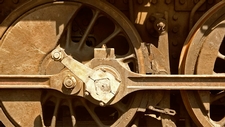Mechanical Energy
Readiness

TEKS Objective
Explore the uses of energy including mechanical, light, thermal, electrical, and sound energy.
Essential Understanding
The student knows that energy occurs in many forms and can be observed in cycles, patterns, and systems.
Science Background
Mechanical Energy: The Physics Classroom (website) – Good introduction to mechanical energy, which is the energy that is possessed by an object due to its motion or due to its position.
Mechanical Energy
The Physics Classroom, www.physicsclassroom.com
Differences Between Solar and Mechanical Energy: eHow (website) - Simple explanations about energy and the significant differences between solar and mechanical energy.
Differences Between Solar and Mechanical Energy
by Timothy Banas, eHow, www.ehow.com
Signature Lesson
Move It: TeachEngineering (website) - Students learn about mechanical energy by investigating how the conservation of energy applies to impact situations, such as a car crash or an object falling to the ground.
- Supporting Lessons
- Extensions
- Assessment Ideas
- Literature Connections
- Related
TEKS - Additional Resources
Supporting Lessons
A River Ran Through It: TeachEngineering (website) - Hands-on activities, focusing on falling water and waterwheels, which teach students how water is used to generate electricity and allow investigation of water’s potential-to-kinetic energy transformation.
A River Ran Through It
TeachEngineering, www.teachengineering.org
The Ultimate Roller Coaster Contest: Discovery Education (website) - Fun lesson in which students design and construct a cardboard “roller coaster” to explore mechanical energy, both as gravitational potential energy and as kinetic energy. Includes discussion questions, assessment and extensions.
The Ultimate Roller Coaster Contest
Discovery Education, www.discoveryeducation.com
Elaboration Lessons and Extensions
Paper Rockets: NASA (website) - Students experience mechanical (kinetic) energy as they build and launch paper rockets.
Paper Rockets
by Gregory Vogt, NASA, www.microgravity.grc.nasa.gov
Rocket Car: NASA (website) - Students investigate mechanical (kinetic) energy as they construct a car to demonstrate the action and reaction that enable rockets to move.
Rocket Car
by Gregory Vogt, NASA, www.microgravity.grc.nasa.gov
Rocket Racers: K8 Science (video) – Watch this presentation by Dr. Gregory Vogt to learn the science behind the Rocket Car Racers, and how to build the racers with students using simple materials.
Rocket Racers
by Gregory Vogt, K8 Science, www.k8science.org
Assessment Ideas
Lead a class discussion about the potential and kinetic energy present in a roller coaster. Have students make drawings that illustrate these concepts, with labels to identify the potential and kinetic energy.
Literature Connections
Wind Power: Energy for the Future and Global Warming. Saunders, N. (ISBN-13: 978-0836884142)
Mechanical Engineering. Herweck, D. (ISBN-13: 978-0756539528)
A Crash Course in Forces and Motion with Max Axiom, Super Scientist. Sohn, Emily (ISBN-13: 978-0736868372)
Isaac Newton and the Laws of Motion. Gianopoulo, Andrea (ISBN-13: 978-0736868471)
Additional Resources
Energy Story: Energy Quest (website) - Students explore the energy that makes our world work and learn that energy is an important part of our daily lives. (The page indexes 20 energy lessons.)
Energy Story
Energy Quest, California Energy Commision, www.energyquest.ca.gov
TEKS Navigation
Grade 5
Need Assistance?
If you need help or have a question please use the links below to help resolve your problem.

Comments